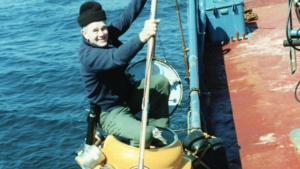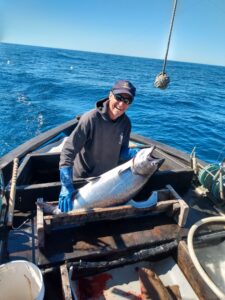
By DANA TIMS/YachatsNews
Accounts of the stunning biological diversity and productivity of an undersea formation 35 miles off Cape Perpetua are hardly new. They first appeared, after all, in the 1775 ship’s log kept by Spanish navigator and explorer Bruno Heceta.
But the Heceta Bank, as the formation is known, continues to marvel everyone from marine researchers to commercial fishing interests, even as calls grow for further environmental protections of the area.

“What’s indisputable is that this is one of the most important biological hotspots on the entire West Coast and even the world,” said Joe Liebezeit, the Bird Alliance of Oregon’s assistant director for statewide conservation. “From the number of fish species to marine mammals to birds, it’s just so unique.”
Despite that acclaim, it’s a fair bet that many residents of Oregon’s central coast don’t know the name, location or importance of a geographical feature created over millennia formed by the subduction of oceanic plates.
The shelf, measuring about 15 miles long and 10 miles wide, is by far the largest of Oregon’s four commonly-identified offshore rocky banks. Along with the three others — Nehalem, Stonewall and Coquille – it breaks up the outer limits of the central Oregon coast’s continental shelf.
At the same time, its rough, craggy landscape provides shelter and spawning areas for a staggering number of marine creatures, making it a prime spot for both research and fishing.
Bill Pearcy, a professor emeritus in Oregon State University’s College of Earth, Ocean, and Atmospheric Sciences, learned that first-hand in the late 1980s, when he was one of the first researchers to step into a submersible vehicle and see for himself the staggering diversity of life that lay beneath the waves.
“The waters around the bank were just unbelievably populated by all kinds of fish of all sizes,” he said in a recent interview. “It was very clear from the outset just how very important this area is for biological productivity.”

Pearcy discusses the vitality encompassing the area in a 30-minute film that had its first showing in Portland this spring to more than 200 people gathered for a preview in OMSI’s Empirical Theater.
The documentary, produced several years ago by Oregon State Productions, breaks the importance of Heceta Bank into a number of chapters. Chief among those are where Pearcy and others weigh in on what make geology and oceanography so important to the bank’s role in promoting biological diversity.
For instance, the film discusses how the bank serves as a huge undersea breakwater for the California Current, which crashes south along the West Coast from British Columbia and ending off southern Baja California Sur.
The productivity of this flow of water is dramatically increased in its biological carrying capacity by the effects of upwelling, which occurs when winds push surface water out of the way, making room for far colder, nutrient-rich, deep-ocean waters to rise to the surface, bringing with them myriad nutrients.
It was the biological activity from this upwelling that prompted Bruno Heceta to note that the waters above the bank were far greener than surrounding areas. All that green, it turns out, is from plankton blooms that feed all the other species higher up on the food web, according to the film.
Kristin Forgrave, a master’s student studying phytoplankton patterns at Portland State University, joined a small panel that discussed the documentary after its showing. She recounted first taking note of the different-colored water on a field research trip.
“We saw a huge blob of phytoplankton,” she said. “And that was Heceta Bank.”

A lure for fishing
Commercial fishermen such as Al Ritter of Waldport have long made the bank a prime destination, precisely because of the fish that thrive on and around Heceta Bank.

“It’s definitely one of my favorite targets,” said Ritter, who fishes the area aboard his trawler, F/V Mickey, which is based in Newport. “It’s consistently one of our top salmon spots.”
In preparing for a typical three-to-four-day outing, Ritter gets up just after 3 a.m., loads up food and other groceries, makes the drive to Newport and heads out over the bar, always accompanied by at least one deck hand.
While the Heceta Bank is always a preferred location, it’s not always an easy one to reach, he said. At 35 or so miles off shore it can be a difficult trip, especially when unfavorable weather or winds are brewing.
But on days when the bank is in play, Ritter said, he rarely has a bad day.
“You know the fish are there because so many birds are flying all over the place,” he said. “You might see whales and all kinds of other things. When it’s happening, it’s a lot of fun. It’s magical.”
Then there’s that name
One lingering debate about the bank is exactly how to pronounce it.
Some, including almost everyone associated with fishing, as well as some scientists, call it “HECK-a-ta” bank. Others, including most of the scientific community, prefer “He-SEA-ta.”
It’s unclear why there is a difference, especially since physical features named after the explorer who sailed these waters nearly 250 years ago are generally referred to as, say, “He-SEA-ta Head” and “He-SEA-ta” Beach.
“Most fishermen call it HECK-a-ta,” Ritter said. “I couldn’t tell you the true pronunciation, if there really is one.”
Liebezeit, the Bird Alliance of Oregon’s conservation point person, has his own take.
“All my life, I’ve been used to having my last name butchered,” he told the OMSI documentary crowd in Portland, chuckling. “So I’m going with the explorer’s family name.”
Make that one more, then, for He-SEA-ta.

Protecting the bank?
One type of fishing not allowed at Heceta Bank is bottom trawl fishing. The area is one of 15 off Oregon’s coast now closed to bottom trawl fishing due to overfishing in prior years. Collectively, these are known as “essential fish habitat conservation areas.”
Some people, including Liebezeit, say further protections are needed to preserve the very qualities that so many agree make Heceta Bank so special.

“Yes, some areas are off limit to bottom trawling,” he said. “But there are other places where there are big concerns. The really high importance in this ecosystem certainly deserves stronger protections.”
But securing any higher levels of safeguards against depletion are, essentially, a political decision, which comes with risks and tradeoffs all their own, Liebezeit said.
“Look at Oregon’s Marine Reserve Protection program,” he said, referring to the five existing marine reserves, where all removal of marine life is prohibited, as is ocean development. “Those, together, account for only nine percent of our ocean waters.”
Cobbling together the political support to expand any protections even further, he said, has historically proved a difficult lift.
That said, Liebezeit noted that commercial fishing interests’ opposition to proposed off-shore wind projects could enable fishermen and environmentalists to come together to support, for instance, a national marine sanctuary around Heceta Bank.
“You could allow some fishing in critical fishing areas, but make those off limits to off-shore wind,” he said. “It’s definitely a flash point, but one that has to involve fully transparent conversations with everyone at the table to talk through it.”
- Dana Tims is an Oregon freelance writer who contributes regularly to YachatsNews.com. He can be reached at DanaTims24@gmail.com
-
To see the 30-minute film on Heceta Bank by OSU Productions, go here



For sure, Heceta Banks do not need protection from the few fishermen that use it. Draggers (trawlers) are the scourge of the ocean floors and they can not fish this area. If the conservationists are serious, they should be banning all wave and wind power stations off our coast.
I feel that to suggest a banning of any critical activity displays a binary approach to problem solving. The ability to coexist with a diversity of interests is key. Must we continue to perpetuate an “us and them” mentality such as the writer’ comments suggest? In my view, fishing interests and sustainable, green energy projects deserve equal consideration if we are to thrive as a species going forward.
If I may, an additional question to ponder: which in the long run is of greater consequence to the marine environment, the development of alternative energy generation utilizing wind and wave energy, or the continued reliance on fossil fuel based energy? I have an opinion based on scientific consensus, but welcome the thoughts of our community.
We will never thrive as a species if we continue to destroy ocean life with overfishing and offshore wind. Can we not have any areas that are protected from both? Can we prioritize other species before ourselves, for once?
To clarify, I submit that our ability to prosper as a species is a question of balance, not of prioritizing our species over another. For example, in order to continue to enjoy the benefits of daily essentials such as access to the electricity required to charge the devices used to facilitate communication such as this, we must learn to balance impacts to the planet and it’s myriad species, while intelligently utilizing her resources. Among other things, I believe this should include sustainable fishing and agricultural practices, alternative energy generation, utilizing wind, solar, and wave energy, and be partnered with environmentally appropriate building and community development.